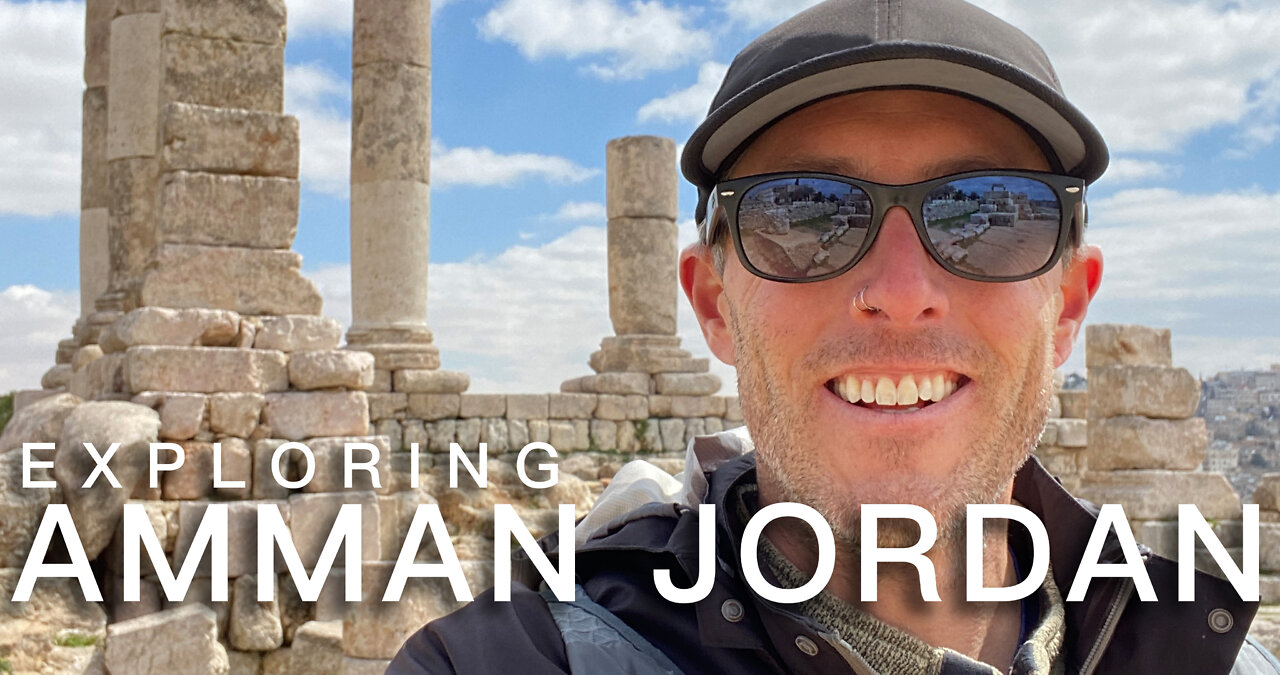Premium Only Content

Amman Jordan Middle East Adventures
Aaron travels to Amman Jordan in the Middle East and explores the region. He has explored the dead sea region from both Israel and Jordan. The colorful art murals in Amman were of particular fascination. Join him as he explores the roman citadel, the temple of Hercules, and the Roman amphitheater.
You can also follow the Sojourner adventures on Instagram
https://www.instagram.com/hisojourner/
ABOUT
AMMAN CITADEL
The Amman Citadel (Arabic: جبل القلعة, romanized: Jabal Al-Qal'a) is an archeological site at the center of downtown Amman, the capital of Jordan. The L-shaped hill is one of the seven hills (jabals) that originally made up Amman.
"The Citadel has a long history of occupation by many great civilizations. Evidence of inhabitance since the Neolithic period has been found and the hill was fortified during the Bronze Age (1800 BCE). The hill became the capital of the Kingdom of Ammon sometime after 1200 BCE. It later came under the sway of empires such as the Neo-Assyrian Empire (8th century BCE), Neo-Babylonian Empire (6th century BC), the Ptolemies, the Seleucids (3rd century BCE), Romans (1st century BCE), Byzantines (3rd century CE) and the Umayyads (7th century CE). After the Umayyads, came a period of decline and for much of the time until 1878 as the former city became an abandoned pile of ruins only sporadically used by Bedouins and seasonal farmers. Despite this gap, the Citadel of Amman is considered to be among the world's oldest continuously inhabited places."
FROM https://en.wikipedia.org/wiki/Amman_Citadel
ROMAN AMPITHEATER
"This magnificently restored theatre is the most obvious and impressive remnant of Roman Philadelphia, and is the highlight of Amman for most foreign visitors. The theatre itself is cut into the northern side of a hill, and has a seating capacity of 6000. The best time for photographs is the morning, when the light is soft – although the views from the top tiers just before sunset are also superb.
The theatre was probably built in the 2nd century AD during the reign of Antoninus Pius (AD 138–61). It was built on three tiers: the rulers, of course, sat closest to the action, the military secured the middle section, and the general public perched and squinted from the top rows. Theatres often had religious significance, and the small shrine above the top row of seats once housed a statue of the goddess Athena (now in the Jordan Museum), who was prominent in the religious life of the city."
FROM https://www.lonelyplanet.com/jordan/amman/attractions/roman-theatre/a/poi-sig/1105394/361068
MOUNT NEBO
"Mount Nebo is a sacred mountain in Jordan standing almost 1,000 meters high. The base of the mountain can be reached within 15 minutes by car from the center of Madaba. From the top of the mountain, visitors can see The Dead Sea, Bethlehem and even Jerusalem on a clear day.
Location of Mount Nebo
Mount Nebo is located just 15 minutes away from the city of Madaba. Madaba is 30 kilometers from the Dead Sea and only a 30-minute drive from Queen Alia International Airport in Amman."
FROM https://www.touristjordan.com/mount-nebo/
VISIT AMMAN JORDAN INFORMATION
https://international.visitjordan.com/
ROYAL JORDANIAN AIRLINES
https://www.rj.com/
US STATE DEPARTMENT JORDAN TRAVEL INFO
https://travel.state.gov/content/travel/en/international-travel/International-Travel-Country-Information-Pages/Jordan.html
JORDAN PASS
https://www.jordanpass.jo/
-
 LIVE
LIVE
Flyover Conservatives
11 hours agoExposing the Left’s Agenda: Border Chaos, Gun Control, and 2028 Predictions - Nick Adams | FOC Show
339 watching -
 LIVE
LIVE
Blockchain Basement
1 hour ago🚨CRITICAL Bitcoin Level To Hold! (China Trump Deal FAILURE!)
139 watching -
 1:00:20
1:00:20
The Rubin Report
2 hours agoThis Fight Over Trump’s Birth Rate Plan Was So Big It Could Be the End of This Host of 'The View'
34.4K26 -
 LIVE
LIVE
The Shannon Joy Show
3 hours ago🔥🔥Medical Murder In America, Will You Survive A Hospital Stay? The Grace Schara Story, Live Exclusive With Her Dad Scott Schara As He Challenges The COVID Kill Protocol In MASSIVE Court Case This June🔥🔥
252 watching -
 DVR
DVR
Benny Johnson
2 hours agoIt Begins: DOJ Will Prosecute CRIMINAL Deep State Intel Criminals, Pentagon EXPOSED on Hidden Camera
31.6K31 -
 LIVE
LIVE
The Mel K Show
1 hour agoMORNINGS WITH MEL K - 4/24/25 Ending Disparate-Impact for Meritocracy, Turning the Tables on Lawfare, Individual Liberty is Our Birthright
731 watching -
 LIVE
LIVE
LFA TV
15 hours agoALL DAY LIVE STREAM - 4/24/25
4,104 watching -
 LIVE
LIVE
Grant Stinchfield
1 hour agoBlood on Their Hands: Maryland's Pro-Illegal Policies Linked More Brutal Murders
119 watching -
 50:46
50:46
BitLab Academy
3 hours ago $0.21 earnedAltcoins Ready!? Critical Bitcoin Signal! Crypto Signals Say This Is Next!
7.43K2 -
 59:52
59:52
VINCE
4 hours agoDoes This Move Mean Justice Is Finally Coming? | Episode 29 - 04/24/25
209K262